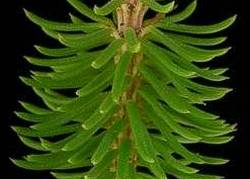Erica abietina subsp. abietina
Erica abietina L. subsp. abietina
Family: Ericaceae
Common names: red heath (Eng.); rooiheide (Afr.)
Introduction
Hikers walking on Table Mountain will experience the delights of the amazing diversity of plant life and the many flowers that are to be seen every month of the year. Anyone walking the higher slopes and plateaus are also likely to see a really lovely red Erica with soft fir-like leaves. Erica abietina subsp. abietina is found nestled amongst rocks or in patches of woody fynbos where it displays beautiful, waxy, red flowers.

Description
Description
Erica abietina subsp. abietina is a sturdy shrub up to 1.5 m high. It arises from a single woody stem and branches freely to produce a dense growth. The mid to upper branches are clothed with a dense arrangement of green, needle-like, ericoid leaves.

The flowers are clustered near the ends of the branches and are bright red, tubular, curved and flared at the mouth. Flowers are produced from midsummer to midwinter, i.e. from December to August, but appear occasionally throughout the year.
Conservation Status
Status
Erica abietina subsp. abietina is common within conservation areas and so this species has been classified in the Red List as Least Concern (LC).
Distribution and habitat
Distribution description
This species is endemic to the upper slopes and plateau of Table Mountain. It is commonly found growing above the 500 m contour amongst rocks in full sunlight.
Derivation of name and historical aspects
History
Erica abietina subsp. abietina is part of the Erica abietina complex (Oliver & Oliver 2002). Other subspecies in the Erica abietina complex are: E. abietina subsp. atrorosea (= E. phylicifolia); E. abietina subsp. constantiana (= E. conica); and E. abietina subsp. diabolis. Another subspecies E. abietina subsp. aurantiaca that was included in the abietina complex has had its independent and original species status re-instated and is now called E. grandiflora.
The name abietina is derived from Latin and means 'like a fir tree', and refers to the leaves which resemble those of fir trees of the genus Abies.
Ecology
Ecology
Erica abietina subsp. abietina is found in Peninsula Sandstone fynbos. This vegetation type consists of poor, well-drained, sandy and stony soils derived from the quartzites of the Table Mountain Series. This erica is one of many red flowered plants found on Table Mountain in summer, which provide food for birds and insects. Its colourful tubular flowers attract sunbirds and the Table Mountain Beauty butterfly, Aeropetes tulbaghia that feeds on its nectar. Some of the other red-flowered species include Crassula coccinea (red crassula), Disa uniflora (red disa) and Disa ferruginea (cluster Disa), Watsonia tabularis (Table Mountain watsonia) and Chasmanthe aethiopica (small cobra lily).
Uses
Use
Erica abietina subsp. abietina is quite hardy in Cape Mediterranean conditions and is a useful addition to a fynbos garden.

Growing Erica abietina subsp. abietina
Grow
Erica abietina subsp. abietina should be planted in gardens where it is in full sunlight and is well ventilated. This species performs best when planted in rockeries on sloping ground, terraces or embankments and with other fynbos plants. Companion plants may include other ericas, buchus, brunias, and restios.
It will also do well in a medium-sized container in a well-drained growing medium: equal parts of composted pine bark or pine needles and river sand, and a little (20%) loam may also be added.
Regular pruning is recommended to keep the plants well branched and compact. Plants that are pruned are more presentable, last longer and produce more flowers.
Erica plants are adapted to living in poor soils and therefore should be regularly fed with diluted organic liquid or small amounts of organic pellet fertilizers.
It is propagated vegetatively by rooting fresh semi-hardwood tip or heel cuttings. Cuttings are rooted in multi-trays on heated benches under mist spray. Cuttings are rooted in autumn or spring in a rooting medium of equal parts bark and polystyrene chips. A semi-hardwood rooting hormone is used to aid the rooting process.
This species grows easily from seed sown in well-drained, acidic, sandy soil and subjected to smoke treatment. Seed is normally sown from late summer into autumn, i.e. March to May.
References
- Adamson, R.S. & Salter, T.M. 1950. Flora of the Cape Peninsula. Juta, Cape Town and Johannesburg.
- Goldblatt, P. & Manning, J. 2000. Cape plants. A conspectus of the Cape flora of South Africa. Strelitzia 9. National Botanical Institute, Cape Town and Missouri Botanical Garden.
- Oliver, E.G.H. & Oliver, I.M. 2002. The genus Erica (Ericaceae) in southern Africa: taxonomic notes 1. Bothalia 32: 37-61.
- Schumann, D. & Kirsten, G. 1992. Ericas of South Africa. Fernwood Press, Vlaeberg, Cape Town.
- Smith, C.A. 1966. Common names of South African plants. Memoirs of the Botanical Survey of South Africa No. 35.
- website: The National Red List of South African Plants (March 2009): http://www.sanbi.org/biodiversity/reddata.htm.
Credits
Anthony Hitchcock
Kirstenbosch National Botanical Garden
June 2009
updated January 2019
Plant Attributes:
Plant Type: Shrub
SA Distribution: Western Cape
Soil type: Clay
Flowering season: Spring, Late Summer, Autumn, Winter
PH: Acid
Flower colour: Red
Aspect: Full Sun
Gardening skill: Average
Special Features:
Horticultural zones







Rate this article
Article well written and informative
Rate this plant
Is this an interesting plant?
Login to add your Comment
Back to topNot registered yet? Click here to register.